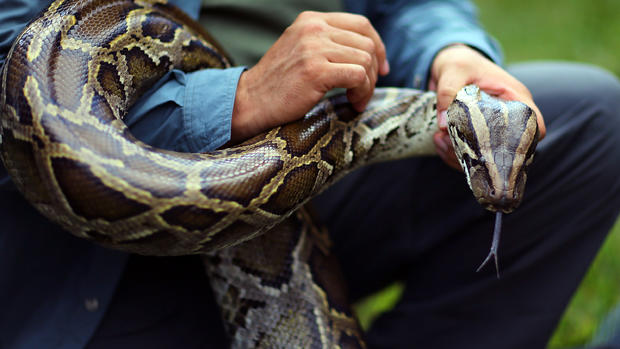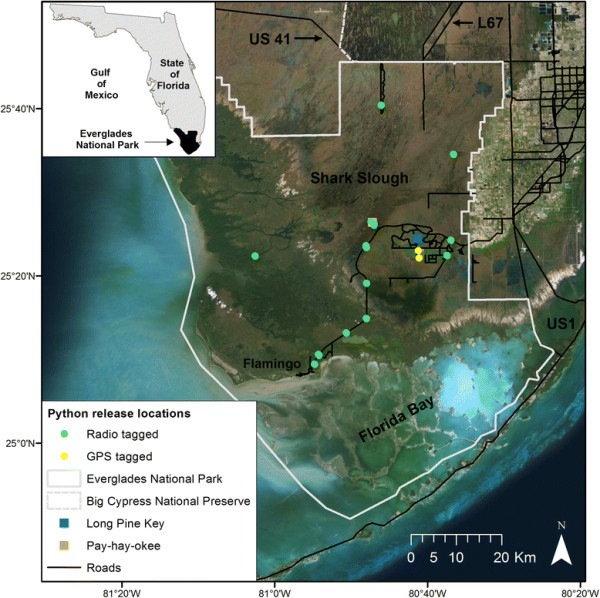How do you find a Burmese python in the Everglades?
There is no shortage of people wanting to rid the Florida environment of the invasive Burmese python.
But the challenge is capturing these reptiles that have been blamed for decimating the wildlife in the Everglades National Park. The last python hunt in 2013 attracted 1,600 hunters from across the country but they only managed to nab 68 snakes.
Now, a team led by the by the U.S. Geological Survey has produced a study they hope could aid those would-be snake hunters.
In the largest and longest Burmese python tracking study of its kind, scientists have identified the size of a Burmese python's home range in the Everglades and discovered they share some common areas also used by multiple pythons - "suitable habitat patches where factors such as prey availability and environmental conditions are favorable."
"These high-use areas may be optimal locations for control efforts and further studies on the snakes' potential impacts on native wildlife," said Kristen Hart, a USGS research ecologist and lead author of the study. "Understanding habitat-use patterns of invasive species can aid resource managers in designing appropriately timed and scaled management strategies to help control their spread."
Hart and her colleagues used radio and GPS tags to track 19 wild-caught pythons in the Everglades, a 10,000-square-kilometer freshwater wetland that covers much of southern Florida. The 5,119 days of tracking data led researchers to conclude that python home ranges are an average of 22 square kilometers, or roughly an area 3 miles wide by 3 miles long, all currently within the park.
"Nowadays, we can get more locations per day and night with the GPS tags which we have not had before," Hart said. "We can collect many more locations per animal per whatever time period. We can piece together an animal's movement path at a much finer scale than if we only used radio tags."
The study in the journal Animal Biotelemetry also found that pythons were concentrated in areas known as slough which contain wet and dry habitat as well as coastal habitats, with tree islands being among their favorite haunts.
"Some tree islands consist of rough terrain with nearly impenetrable vegetation, making surveys for secretive animals in such habitat extremely difficult," the researchers wrote. "To date, no organized searches for pythons on tree islands in (the Everglades) have been initiated, but resource managers may need to give consideration to python search efforts in these habitats as data from radio-tagged pythons indicates that they spend long periods of time there."
The study also found that the park's main road proved no barrier to pythons, with 67 percent crossing the road and very few turning up as road kill.
"It just shows how difficult it is to see them," Hart said. "We definitely know that they crossed the road based on their location. But no one saw them."
These long-lived, large-bodied constricting snakes are native to Southeast Asia and can reach lengths greater than 19 feet. They also produce large clutches of eggs that can range from eight to 107 eggs.
They were first seen in Florida's Everglades National Park in 1979, and thanks to the pet trade, they started showing up in greater numbers in the 1990s. Their numbers have sharply escalated in the past 15 years to the point where Reed and others believe there could be as many as 10,000 there.
With no natural predators, a recent study found they appear to be wiping out most of the small mammals that once thrived in Everglades National Park. They are also chasing out other predators, who have to go elsewhere for a steady diet of rodents, mink, rabbits and raccoons.
With this new data, the scientists hope new methods can be developed to catch these secretive and hard-to-spot snakes. Until now, they have tried everything from trapping, to the month-long Python Challenge to the use of dogs, but snake numbers keep growing.
"A lot of times you go where it's most convenient. You drive along a road looking for pythons, where the chances of encountering them is very low," Hart said. "So, if we can search habitat where we are potential more likely to find them, then we may increase our ability to find more of them."
One new strategy would be tagging a breeding female or male, which then could lead trackers to other snakes that "are interested in breeding with it."
"You could use radio tracking during the breeding season in a very focused location to try to find breeding animals at that site," Hart said.

